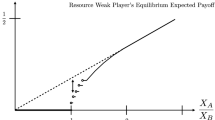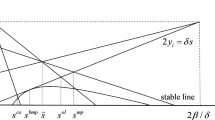Abstract
We derive conditions that must be satisfied by the primitives of the problem in order for an equilibrium in linear Markov strategies to exist in some common property natural resource differential games. These conditions impose restrictions on the admissible form of the natural growth function, given a benefit function, or on the admissible form of the benefit function, given a natural growth function.
Similar content being viewed by others
Notes
The reciprocal, 1/η(c i ), can be interpreted as the instantaneous elasticity of intertemporal substitution.
A more general representation of this utility function is \(u(c_i)=a\big(c_i^{1-\theta}\big)/ (1-\theta) + b\) or u(c i ) = aln c i + b for θ = 1. In the present context, there is no loss of generality in setting a = 1 and b = 0.
A positive β would also have the undesirable implication that the intrinsic growth rate, given by lim x→ ∞ (g(x)/x), is infinite.
It can be shown that there also exist equilibria in affine strategies with the quadratic utility function (32) when either θ = 0 or β = 0, conditional on proper restrictions on the parameters to assure γ i < 0, as was the case for the affine strategies discussed in the previous section.
We thank Ngo Van Long for suggesting this extension.
References
Clemhout, S., & Wan, H. Y. (1985). Dynamic common property resources and environmental problems. Journal of Optimization Theory and Applications, 46, 471–481.
Dockner, E., Jorgensen, S., Long, N. V., & Sorger, G. (2000). Differential games in economics and management science. Cambridge: Cambridge University Press.
Fischer, R., & Mirman, L. J. (1992). Strategic dynamic interactions: Fish wars. Journal of Economic Dynamics and Control, 16, 267–287.
Fischer, R., & Mirman, L. J. (1996). The compleat fish wars: Biological and dynamic interactions. Journal of Environmental Economics and Management, 30, 34–42.
Levhari, D., & Mirman, L. J. (1980). The great fish war: An example using a dynamic Cournot–Nash solution. The Bell Journal of Economics, 11(11), 322–334.
Long, N. V., & Shimomura, K. (1998). Some results on markov equilibria of a class of differential games. Journal of Economic Behavior and Organization, 33, 557–566.
Plourde, C., & Yeung, D. (1989). Harvesting of a transboundary replenishable fish stock: A noncooperative solution. Marine Resource Economics, 6, 57–70.
Author information
Authors and Affiliations
Corresponding author
Additional information
We wish to thank Rabah Amir, Hassan Benchekroun, Pierre Lasserre, and Ngo Van Long for their useful comments on an earlier draft and two anonymous referees for suggestions which led to improvements to the paper. This research has benefitted from financial support from the Social Sciences and Humanities Research Council of Canada and the Fonds québécois de la recherche sur la société et la culture.
Appendix
Appendix
In this appendix, we verify the conditions for existence of an equilibrium in affine strategies, given the utility function (17).
Assume the strategies φ j (x(t)) of the n − 1 players j ≠ i to be given by φ j (x(t)) = γ j + δ j x(t). Then the equation of motion facing player i in choosing his own decision rule c i = φ i (x(t)) becomes:
and the current value Hamiltonian associated to his problem becomes:
Assume φ i (x(t)) = γ i + δ i x(t) to be a solution. Then:
or, substituting from Eq. 43:
Furthermore, from the necessary conditions (7) and (8), along an interior solution,
Equalizing Eqs. 45 and 46, we find that for any utility function u(c i ), in order for c i = γ i + δ i x to be a best response, the following differential equation must be satisfied:
where δ i , γ i , the δ j ’s and the γ j ’s, j ≠ i remain to be determined.
With η(γ i + δ i x) = θ ≠ 1, this becomes:
where
and
which has as solution:
k being the constant of integration.
Therefore, in order for φ i (x(t)) = γ i + δ i x(t) to be a best response to affine strategies on the part of player i’s rivals, the growth function must be of the form:
Differentiating and substituting into Eq. 47 we get:
Choosing k = 0, constant equilibrium values of δ i and γ i , i = 1, ..., n are obtained by simultaneously solving:
and
It is easily verified from Eq. 49 that
is the solution for γ i , with δ i obtained from Eq. 48.
The existence of an equilibrium in affine strategies therefore requires that g(x) be an affine function of the stock (β ≠ 0). To be implementable, β should be negative (δ i being positive), as otherwise it would imply that a positive quantity can be harvested from a zero stock. As argued in the text (footnote 5), β < 0 is also necessary for g(x) to be a sensible representation of the growth of a renewable resource stock. Hence, the decision rule will be c i = max {0, γ i + δ i x} so as to satisfy the necessary conditions (Eq. 7). Note that the solution for δ i is the same as in Eq. 21.
Similar calculations can be carried out to solve for an equilibrium in affine strategies in the case of θ = 1.
Rights and permissions
About this article
Cite this article
Gaudet, G., Lohoues, H. On Limits to the Use of Linear Markov Strategies in Common Property Natural Resource Games. Environ Model Assess 13, 567–574 (2008). https://doi.org/10.1007/s10666-007-9118-2
Received:
Accepted:
Published:
Issue Date:
DOI: https://doi.org/10.1007/s10666-007-9118-2




